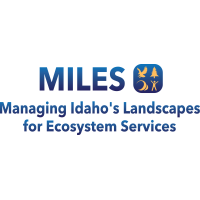Idaho, USA has a high percentage of federally owned land (over 60%), strong gradients in elevation and latitude, diverse landscape types and uses, the third fastest growing population in the United States, and is one of the most agriculturally productive states in the county. Knowledge of how different biophysical and socioeconomic functional classes in Idaho are distributed and overlapping is of particular interest in this region, and the intersection of these landscapes describe a foundational aspect of the socio-economic system (SES) in that area. Contemporary interest in SES has spawned efforts to map SES boundaries, but these studies are few in number, and do not converge on a consensus approach. We adapted aspects of previous studies to develop an improved methodology for mapping SES boundaries in Idaho. We performed a spatially explicit, nested Principal Component Analysis (PCA) on suites of biophysical and socio-economic data aggregated by 5 km grids, followed by a comparison of two common, but mathematically distinct clustering techniques, k-means and Agglomerative Hierarchical Clustering (AHC), to classify homogeneous functional classes across the state.
To address the issue of non-independence inherent to spatial datasets, we included XY coordinates in the PCA, but removed them for score calculation, thereby holding spatial locations constant without explicitly including them in score-based clustering analyses. Both K-means and AHC generated outputs with a high percent agreement between analogous numbers of clusters, although cluster evaluators did not converge on a single most likely number of clusters for either dataset, biophysical or socioeconomic, and the median evaluator score was used to select a most likely number of clusters. Generally, AHC resulted in a greater number of likely clusters than did k-means, thus providing better resolution - particularly in urban areas. Composite SES maps were created by overlapping the shared 5km grid geometry of the classified biophysical and socioeconomic landscape maps, and distinct SES domains emerged. We detected notable differences in management interpretations between the k-means and AHC composite SES maps, given a small difference in the number of landscape classes selected by clustering analysis.
This research is funded by the NSF Idaho EPSCoR Program and by the National Science Foundation under award number IIA-1301792. The research reported in this paper contributes to the Programme on Ecosystem Change and Society (www.pecs-science.org), and the EPSCoR Managing Idaho Landscape for Ecosystem Services iSEED Award, “Towards ONEIdaho: An investigation of social-ecological system boundaries and domains across MILES sites.” Special thanks to Drs. Danelle Larson and Donna Lybecker. We also acknowledge Idaho State University, where this research took place.
Data and Resources
| Field | Value |
|---|---|
| Modified | 2019-03-18 |
| Release Date | 2018-10-01 |
| Publisher | |
| Identifier | 4fa992c8-ec59-4157-a8b0-8a48290d1263 |
| Spatial / Geographical Coverage Area | POLYGON ((-117.24609375 41.932252850687, -117.24609375 48.977814000177, -110.91796875 48.977814000177, -110.91796875 41.932252850687)) |
| Spatial / Geographical Coverage Location | Idaho, USA |
| Temporal Coverage | Thursday, January 1, 1981 - 00:00 to Sunday, January 1, 2012 - 00:00 |
| Language | English (United States) |
| License | |
| Granularity | 5 kilometer |
| Author | |
| Contact Name | Susan B. Parsons |
| Contact Email | |
| Public Access Level | Public |
| DOI | 10.7923/G4N877T0 |


![[Open Data]](https://assets.okfn.org/images/ok_buttons/od_80x15_blue.png)